Can Michelin’s Green Star Create a Truly Sustainable Culinary Future?
Oakland's esteemed Chabot Space & Science Center, home to NASA’s Ames visitor outpost, is typically a hub for stargazing and cosmic discovery. But this evening, it plays host to an entirely different kind of stardom—the glimmering allure of the Michelin star. As the locale for the 2023 Michelin Guide presentation for California, the setting is buzzing with chefs, celebrities and, a hybrid of the two, celebrity chefs—including the likes of Thomas Keller, Curtis Stone, Brandon Hayato Go, and Kyle Connaughton.
They stride down the red carpet, commanding the attention of cameras like A-listers at the Oscars. The impending award ceremony fades into the background as they relish this brief break. Away from the heat of the kitchen and without their white jackets, it's a night to bond and revel with fellow culinary masters.
Alexis Garcin, president and CEO of Michelin North America, praises California for its culinary brilliance, impeccable service, and commitment to sustainability. The masterminds behind prized restaurants in the region ascend the stage to claim their Michelin jackets. The Young Chef award goes to Harrison Cheney of San Francisco’s Sons & Daughters. John Haffey of Aubergine earns Sommelier of the Year, moving his wife to tears of happiness. John Schafer, director of operations at SingleThread in Healdsburg, is honored with the California Service Award for the year.
As the night draws to a close, the California selection highlights 614 gastronomic destinations, representing 61 different cuisines. Of these, 87 establishments are graced with those much-hyped Michelin stars. Six restaurants celebrate their inaugural Michelin star, another six score three stars, and four are recognized with something less familiar: their debut Green Star for sustainability.
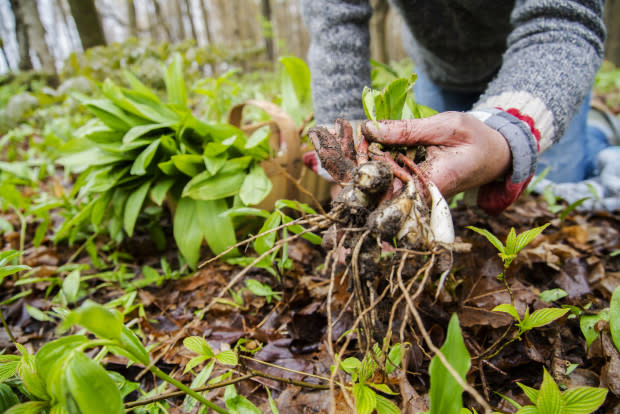
Getty Images
What Is the Michelin Green Star?
Introduced in 2020, the Michelin Green Star underscores restaurants at the forefront of the industry when it comes to sustainable practices. These establishments don't just serve extraordinary food—they consciously strive for environmental and ethical harmony. Through collaborations with sustainable suppliers and producers, minimizing waste, and phasing out plastic and non-recyclable materials, they set an exemplary standard in their supply chain.
“We’ve been on the thread of sustainability for a long time,” Garcin says. “The Green Star represents our longstanding commitment to support sustainability in gastronomy.” As for the automotive side, Michelin launched its first green tires in 1992, helping to reduce gas consumption by seven percent. The company aims to manufacture exclusively renewable and recyclable tires across all product lines by 2050.
“These are values that are in alignment with my own,” Garcin adds, “and part of the reason I’ve been with Michelin for more than 20 years.”
Garcin started at Michelin in 2002 as its head of sales in France. He’s held seven different roles at the company. “Working in this way and traveling around the world has taught me to better understand how people are connected, and how we can learn from each other no matter the career position, gender, nationality, or culture,” he says.
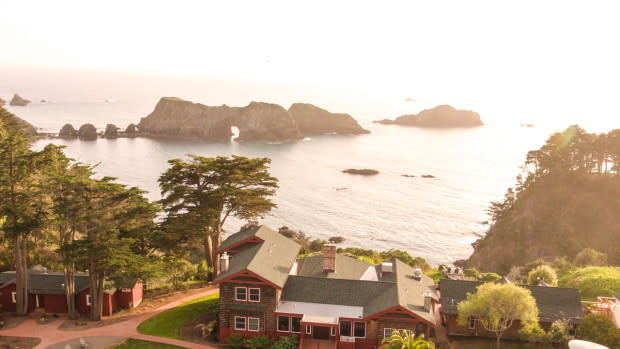
Courtesy of Harbor House Inn
Michelin's Road to Sustainability
To get an immersive understanding of sustainability in both dining and travel, Garcin and I embark on a road trip through Northern California, visiting Michelin Green-Starred gems Harbor House Inn and SingleThread. In line with Michelin's ethos, Garcin ensures we travel in style in a 2023 Porsche Taycan 4 Cross Turismo electric sports car complete with Michelin Pilot Sport 4 tires.
The Michelin Guide debuted in France in 1900 as a strategy to boost tire sales. Originally, it guided tourists in locating reliable lodgings, eateries, and automobile service stations in France. In 2005, the company released its inaugural American guide, spotlighting New York City's fine dining scene. Over the years, the esteemed Michelin star rating system has grown in influence, profoundly shaping the culinary landscape and tourism.
I jokingly ask Garcin if he dines on Michelin-starred delicacies daily. But it turns out he's never experienced multiple starred establishments in a single day. For both of us, eating our way through five stars in a 24-hour period feels truly special.

Courtesy of Harbor House Inn
Harbor House Inn: Hyper-Local Seafood Amid the Redwoods
Leaving Marin County, we drive north through Navarro River Redwoods State Park along the Navarro River. Where the forest meets the Pacific Ocean is just a few minutes’ drive to the Michelin two-starred Harbor House Inn, a boutique hotel and restaurant run by Chef Matthew Kammerer.
Perched on a cliff on California's Route 1, Harbor House Inn’s cottagecore aesthetic is a testament to the beauty of the redwood timber since its construction in 1916. A $10 million facelift in 2018 transformed the inn from quaint to sophisticated.
Chef Kammerer, a New Jersey native, believes he was destined to be at Harbor House.
“I had detailed it all out in my journal: a historic building, 10 rooms, ocean view, everything,” he says. “My search began in Northern Washington, moving southward until my vision matched reality.”
Staying at Harbor House Inn is a retreat to the natural landscape. There are intentionally no TVs.
“The ocean and the forest are your television set,” Kammerer says. “The wildlife and environment provide the show. We want people to embrace that.”
That afternoon, we watched a dozen humpback whales breaching and playing in the bay, while small deer wandered into the garden to nibble on fresh-grown herbs. It’s hard not to feel like this should be mandatory viewing.
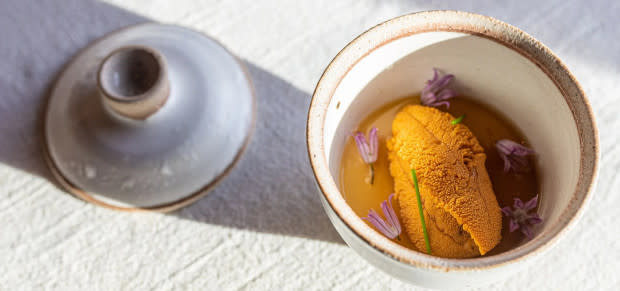
Courtesy of Harbor House Inn
Still, the focal point at Harbor House Inn is Kammerer’s eight- to 12-course tasting menu, reflecting the raw beauty of the Mendocino coastline and forests, with a focus on seafood and vegetables. The menu celebrates hyper-local and foraged ingredients, turning both high-end products like red sea urchin and everyday finds such as seaweed or lace lichen (a combination of fungi and algae that hangs from trees) into gourmet dishes.
“Everything we do at the restaurant begins with taste,” Kammerer says. “What’s beautiful about our farm is that we can use a plant throughout its life cycle—shoots, flowers, roots, stems, and leaves. Our menu changes daily based on what’s available locally and what it tastes like. We're in constant conversation with nature.”
The mission, as he tells it, is to create a singular dining experience that conveys the surroundings, course by course. Highlights of the evening include the last of this season’s Dungeness crab poached in seawater, abalone steamed in ash dough, black cod smoked over bay laurel, and red sea urchin served with chawanmushi (a savory Japanese egg custard) and seaweed flakes.
After dinner (and four dessert courses), we gather around a bonfire by the sea bluffs to look at the stars, untouched by light pollution.
“I've been here nearly six years,” Kammerer says. “As this area develops, we strive to maintain its beauty. Things that plague other areas simply haven't reached here yet. Our unwavering commitment to sustainability is not just operational; it's a tribute to preserving the natural essence of this beautiful place.”
Unfortunately, restaurants typically produce a lot of waste—plastics, packaging, food, even water. But that’s where Kammerer and his team look at things differently. “We avoid plastics typically used for food storage and we never prepare more food than we need. If we have 18 guests, we cook 18 meals,” he notes. “The candles in the restaurant are made locally from the oil we use for cooking. And our guests receive the candles as parting gifts. It’s all part of our story and the experience we provide.”
After Harbor House Inn, we head to Sonoma County. Taking in the magnificent redwoods again underscores the necessity of their conservation. And if our journey visiting these beautiful places and learning from the people who respect them has taught me anything, it’s that we’ve got to do better to protect the forests and the heartbeats that inhabit them.
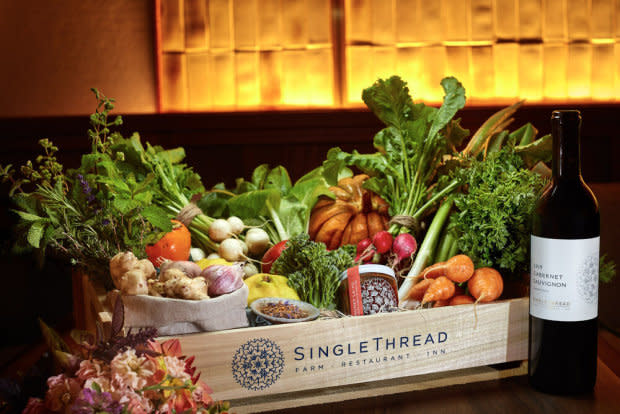
Courtesy of SingleThread
SingleThread: Duclair Duck and Perfect Wagyu
We arrive at SingleThread Farms mid-morning to meet up with head farmer Katina Connaughton and chef Kyle Connaughton (Katina’s husband) for a tour of the farm. The couple’s sprawling 24-acre property in Dry Creek Valley isn't just picturesque; it's the lifeline of their Michelin three-starred restaurant, SingleThread. The farm supplies seemingly endless culinary crops and vibrant flowers cultivated across seasons, yielding not just nutrient-rich produce, but also a thriving ecosystem.
"Every harvest, every bloom, every flavor from the farm is relayed to the restaurant daily, guiding each evening's menu," Katina explains. She turns into the garden and plucks a few varieties of tomatoes and strawberries for us to try. “What you're tasting now is exactly how it will taste tonight in the restaurant.”
The farm and restaurant form a symbiotic relationship where constant communication dictates success. And it’s clear the restaurant team deeply values the effort put into their farm, understanding that nature's unpredictability can challenge a harvest. It could take months to produce the perfect tomato that's served the same day it's received in the kitchen. Chef Kyle and his team honor this journey, ensuring they cook with care and avoid waste. “My role as chef is to showcase the hard work of our farmer,” he says.
The dedication is obvious, especially given that SingleThread has been awarded additional accolades for service and sustainability. Speaking of sustainability, SingleThread is an emblem of eco-consciousness. Its organic farm produces 70 percent of the menu's ingredients, relies on natural water sources, and boasts over 100 olive trees that supply the restaurant's olive oil needs. Every floral adornment in the LEED-certified dining room is cultivated here or sourced from nearby forests.
“We have a very specific viticulture area here in the valley noted by specific soils and determined by climate, geography, and topography,” Katina says. “The varietal for this area is chardonnay and most of the land here is used for that. But when we introduce and express our farm with a range of florals, vegetables, and fruits, we're also supporting biodiversity across the region.”
Set in Sonoma’s wine country, SingleThread is a haven where sublime culinary art meets unparalleled hospitality. The Connaughtons’ vision has been heavily influenced by their time in Japan. This is evident in the restaurant's kaiseki-inspired cuisine, a traditional multi-course Japanese dinner, and the meticulous practice of omotenashi, the Japanese philosophy of wholehearted hospitality.
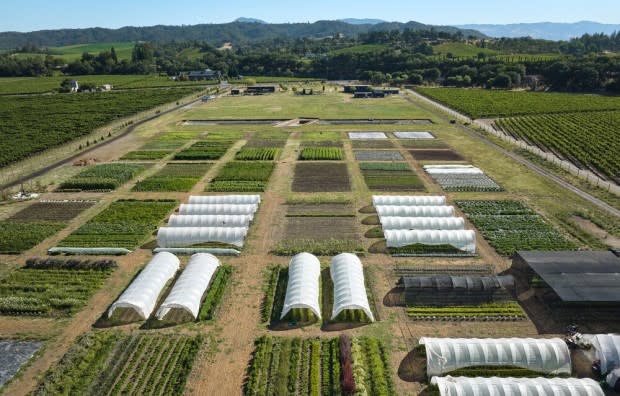
Courtesy of SingleThread
“It informs and inspires a lot of what we do," Kyle says. "And while we’re very connected to artisans and fisheries in Japan, we're not a Japanese restaurant. This isn’t Japanese food. We study the underlying principles and apply them authentically to our varieties, terroir, and seasons, rather than try to copy it or import it.
The dining room integrates the Fibonacci sequence, known as the "law of nature," as it commonly appears in the natural world. The sense of balance, whether in the petals of a flower or the spirals of cauliflower, is echoed in the design, merging warmth and precision. This sequence is reflected in carpet patterns, leather-wrapped columns, Japanese shoji screens—even the room sizes emphasize that golden ratio.
Before the 11-course dinner, we're treated to a moss-layered montage: local butter clams with sorrel and wasabi, sardines in a delicate marinade, roasted beets, pickled oysters on the half shell.
Then we get into the serious stuff. Nodoguro (also known as rosy seabass) and red sea urchin with seaweed puree are melt-in-your-mouth pleasures. Black cod is smartly paired with a broth crafted from its grilled bones and Saikyo Miso. Duclair duck, perhaps calling back to Chef Kyle's tenure at Michelin three-starred The Fat Duck in England, stands out as a hearty strip, boasting crispy skin and rich fat beneath. But the crown jewel for me is Japanese A5 Wagyu, perfectly accompanied with chanterelle mushrooms, Imai onion, and summer truffle. It pairs beautifully with the tea and cherry notes of a 2017 Biondi-Santi Brunello di Montalcino.
A final course of smoked scallop is served with Brentwood corn, pork cheek, and luna rice, washed down with a 2010 Chateau d'Yquem from Sauternes, France, that gives honey, candied orange, and crème brulee. This exquisite finale makes way for a procession of dessert courses including a beautiful wagashi confections made with blueberry and pineapple sage.
After, we hop up to the rooftop deck with Chef Kyle to share stories and bourbon beside the fire. Surprisingly, after our lavish feast, I'm not completely stuffed. Instead, I feel a bit energized. Chef Kyle has a theory.
"As chefs, we act as conduits, channeling energy from one life form to another. By using nutritious and naturally flavorful ingredients, we can avoid heavy additives like butters and creams. This pure energy transfer invigorates and our bodies respond positively."
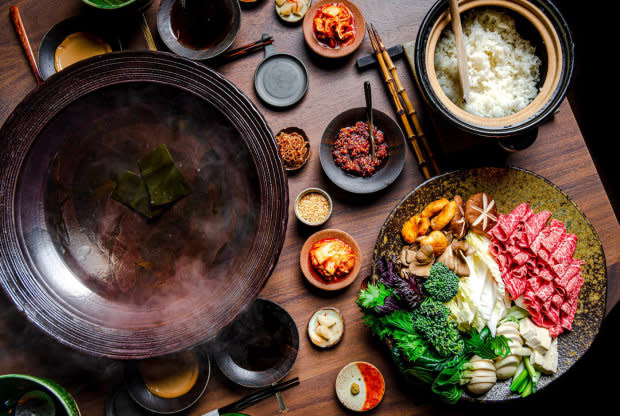
SingleThread
Pro tip: Guests who stay in SingleThread’s five premium guest rooms don't just have access to luxury digs (including Japanese Toto toilets, a soaking tub, and walk-in rain shower). An exclusive family-style, in-room hot pot donabe dinner is available. The wagyu shabu shabu option is served with donabe steamed rice, pickled vegetables, Japanese farm greens, negi scallions, tofu, local mushrooms, ponzu, and sesame dressing.
Determining the Future of Sustainability
As we stand at the crossroads of innovation and tradition, sustainability shouldn't be seen as a trend, but as an imperative shift for our future. The choices we make today will shape the legacy we leave for generations to come. It's a journey of collective responsibility, where every effort counts and passionate people like Kammerer and the Connaughtons work tirelessly to help illuminate the way. The horizon promises a brighter, greener future, but only if we move toward it with purpose and determination.
And if Michelin can be a significant part of that sustainable haute-cuisine future, well, why not? The tire company has already influenced dining in innumerable unlikely ways.
“It’s all about people and their passion for excellence that's very evident in the food industry at this level," Garcin says. "At Michelin, this kind of intertwining of individuals and their passion is deeply embedded in our DNA. Witnessing it all converge here in Northern California is truly humbling."
